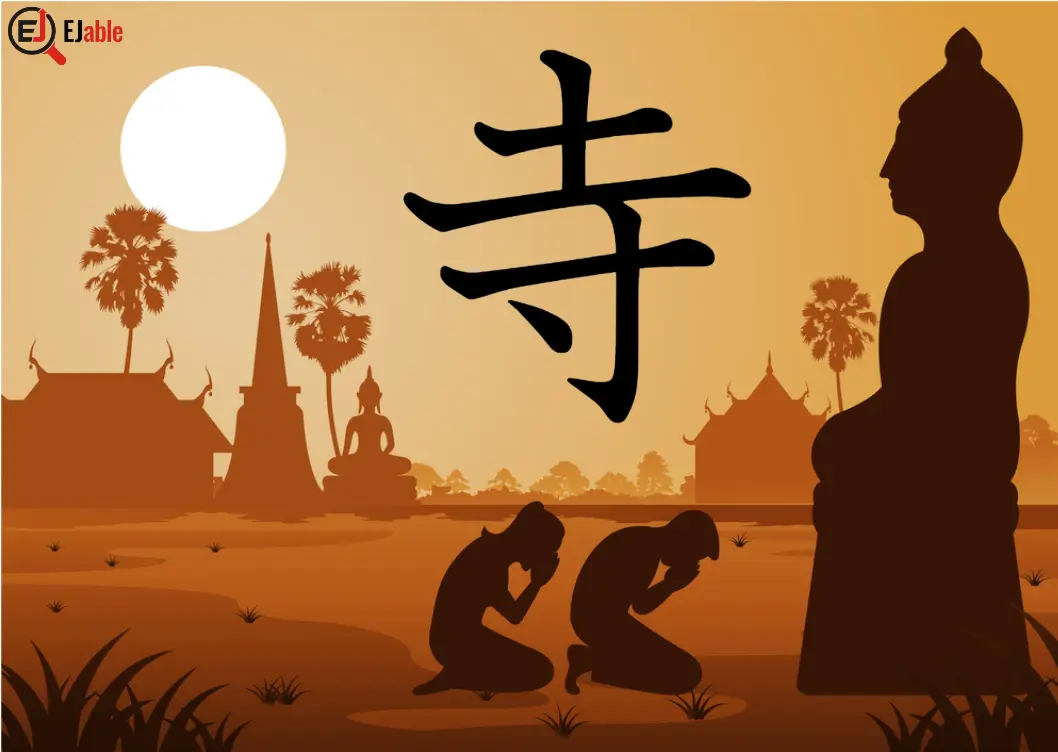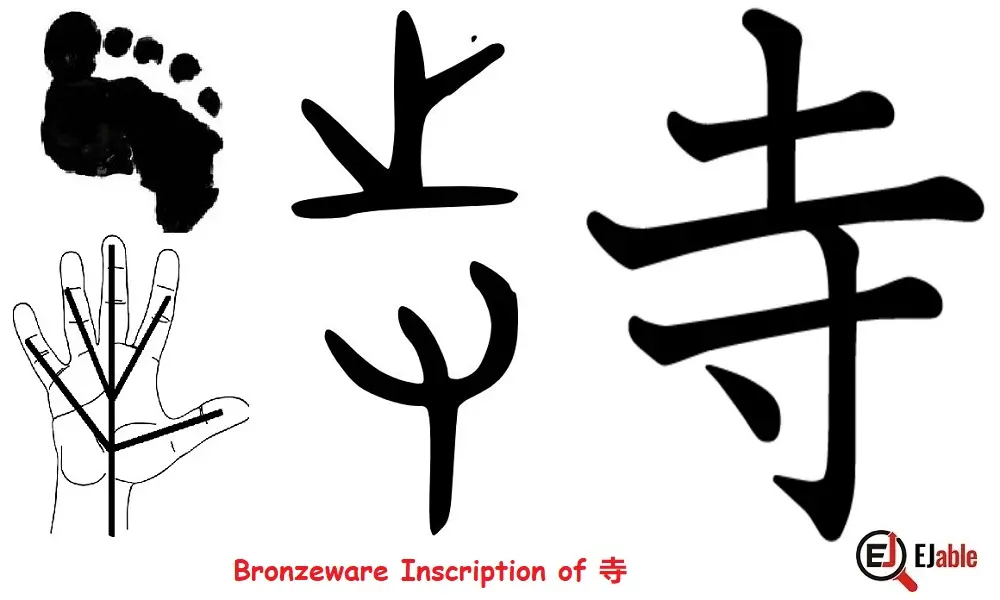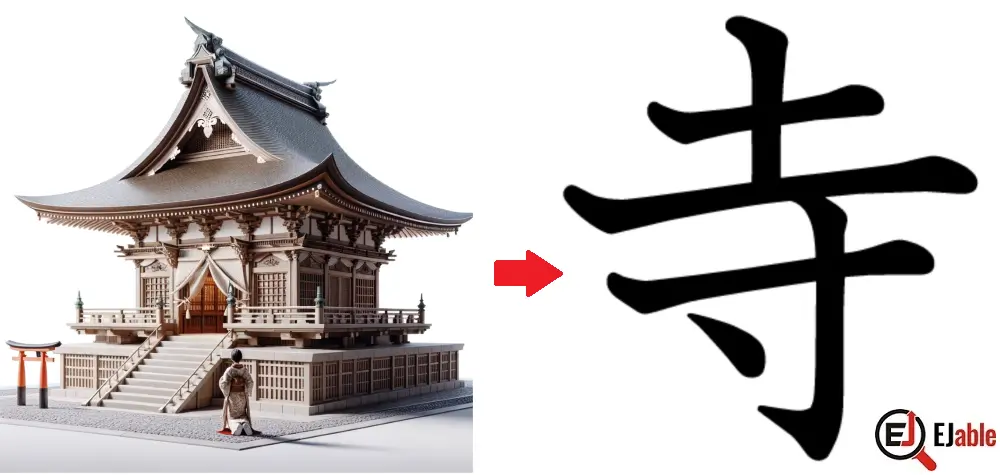Kanji for Temple: 寺 (Tera)

The Japanese Kanji for “temple” is 寺. The Kunyomi or the Japanese pronunciation of the Kanji 寺 is tera (てら), and the Onyomi (Chinese) pronunciation is ji (ジ).
Temple’s Kanji is part of JLPT N2 and is taught in grade 2 in Japanese schools.
Origin of Shape 寺
Temple’s Kanji 寺 is constructed with 6 strokes. At first glance, the construction of the Kanji 寺 seems to have two Kanji characters as follows:
- Kanji for earth or ground 土 at the top
- Kanji for smallness or tininess 寸 at the bottom
However, if we see the ancient Bronzeware Inscriptions of this Kanji, we see the shape of a foot at the top and a hand at the bottom. Please note that even the character relates to a hand.
Check the ancient/ shape of the kanji meaning temple and its evolution to the current shape in the following illustration:


So, how does a combination of a foot and hand relate to a temple?
Well, the Kanji 寺 is one of those Kanji characters that did not only undergo an evolution of shape but its meaning also evolved.
Traditionally, in the Chinese pictographic writing system (Kanji), a foot represented stopping or halting, as well as moving a step.
On the other hand, a hand could denote holding on to something. The combination of these two characters can represent “halting and holding”, and in other words, “to sustain” or “to keep”. Therefore, we can assume that the original meaning of this Kanji was related to sustaining or keeping.
However, during the Han dynasty, this kanji, which now means temple, represented a government office. After all, a government office has the power and control over society to strengthen the rules & regulations to sustain the society.
Over time, this Kanji changed its meaning, and people started using it to mean a temple. After all, societies always believed in the ultimate power of God to sustain humanity.
Mnemonic: How to Easily Remember the Kanji for Temple 寺
We can go into the history and origin of 寺, as discussed above. However, most people who have been learning Kanji for some time remember 土 as the Kanji for ground or earth.
Similarly, the Kanji 寸, meaning smallness or tininess, is a part of many important Kanji characters, so it’s easier to have a mnemonic that represents these two shapes as we know them.
Considering the above, let’s use the following illustration as the mnemonic to remember 寺 as the Kanji meaning a temple:


Explanation
Before we explain the above illustration as the mnemonic, please note that the top part of 寺 resembles so beautifully the top parts of Japanese shrines.
However, consider the Kanji 寺 comprising of “ground (土)” and “smallness or tininess (寸)”. Now consider the above picture of a human being praying at the temple grounds. Isn’t a temple a place where we are supposed to give up our egos and realize our smallness in front of the greatness of God? If you remember this simple explanation, you will not forget 寺 as a temple if you already know the meanings of 土 and 寸.
Temple (寺) Kanji in Compounded Words
The Kanji 寺, meaning temple, commonly appears in many compounded Kanji characters. There are 23 Japanese words that begin with the Kanji 寺, and it appears in 75 words.
Examples of Kanji 寺 in Compounded Kanji Characters
Following are some compound words that use the “temple” (寺):
- 寺院 (じいん / jiin): Temple; Buddhist temple grounds.
- 大寺 (だいじ / daiji): Large temple.
- 山寺 (やまでら / yamadera): Mountain temple.
- 寺子屋 (てらこや / terakoya): Traditional Japanese school in a temple.
- 寺門 (じもん / jimon): Temple gate.
- 寺家 (じけ / jike): A house belonging to a temple.
- 本寺 (ほんでら / hondara): Head temple; main temple.
- 別寺 (べつでら / betsudera): Branch temple.
- 末寺 (まつでら / matsudera): Subordinate temple.
- 寺域 (じいき / jiiki): Temple precincts.
- 寺務 (じむ / jimu): Temple affairs; temple business.
- 寺社 (じしゃ / jisha): Temples and shrines.
- 寺号 (じごう / jigō): Temple name.
- 寺内 (じない / jinai): Inside the temple; temple grounds.
- 寺役 (じやく / jiyaku): Temple official; temple duties.
These compound words demonstrate the varied use of 寺 in contexts related to Buddhist temples, their structures, operations, and related cultural or religious concepts in Japan.
寺 as a Component in other Kanji Characters
The Kanji 寺, meaning temple, appears as a component in 18 other Kanji characters. Out of these 18 Kanji, 8 are Jōyō, or commonly used Kanji characters, with the temple are as follows:
- 時 (ジ / Ji, とき / Toki): Time or Occasion
- 持 (ジ / Ji, もつ / Motsu): To have or to hold
- 特 (トク / Toku): Special
- 待 (タイ / Tai, まつ / Matsu): To wait
- 等 (トウ / Tō ,ひとしい / Hitoshii): Equal, Similar
- (シ / Shi): Poetry, Poem
- 侍 (ジ / Ji, さむらい): Samurai
- 蒔 (まく / Maku): To sow, To plant
Check other Kanji characters on the page “How to Remember Kanji“. You may also like to read about the common Kanji radicals.


A long-term ex-pat in Japan, Himanshu comes with an IT background in SAP consulting, IT Business Development, and then running the country operations of an IT consulting multinational. Himanshu is the co-founder and Managing Director of ReachExt K.K. and EJable.com. He is also an Advisory Board Member of a Silicon Valley AI/IoT startup.

